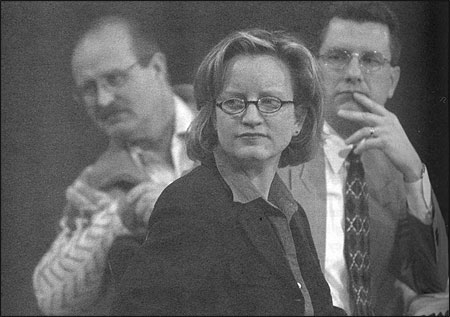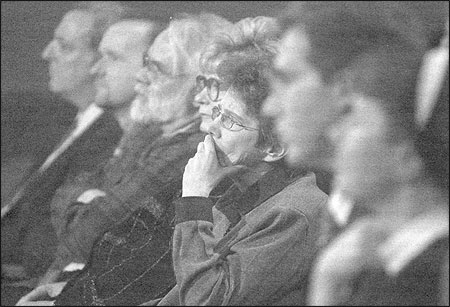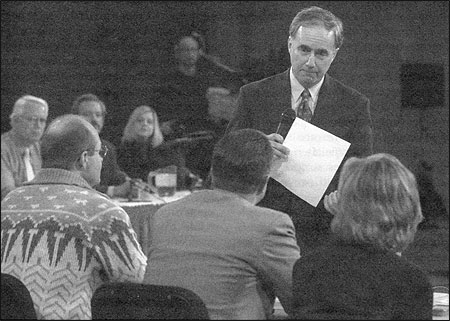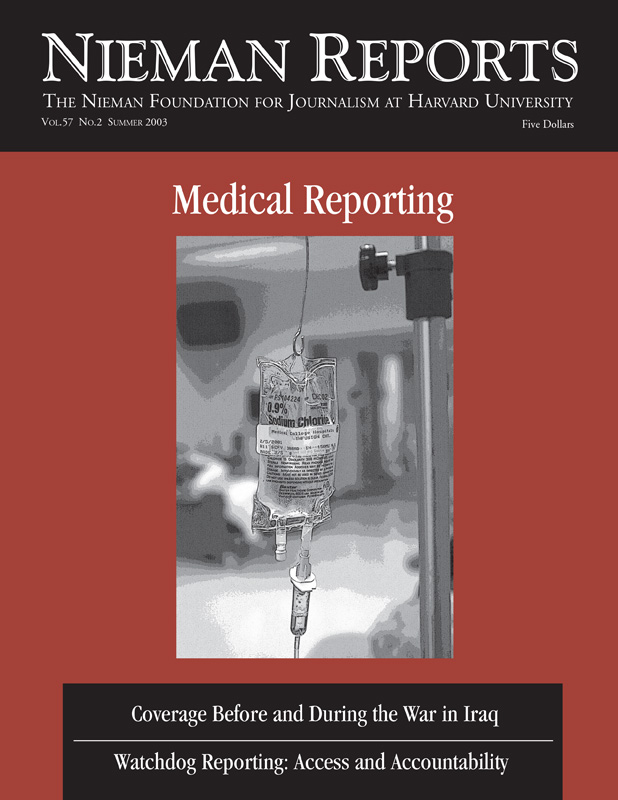Nebraskans know what to expect from the arrival of spring: sandhill cranes returning to the Platte River, forsythia bursting into yellow bloom, the Cornhusker football team rolling onto the practice field. But three years ago, spring brought with it news of something so new—and some would say so contrary to the rhythms of nature—that it stirred a troubled debate.
The revelation: Researchers at the state’s medical center in Omaha had been using tissue from aborted fetuses to seek cures for diseases such as Parkinson’s. Pro-life, pro-choice and other forces soon were fully engaged in strident discourse. State senators also began a contentious debate about whether to forbid the research. In the span of a few weeks, ordinary Nebraskans went from not even knowing that such experiments were possible to the discomfort of grappling with the ethics of what was happening.
It was during that troubled Nebraska spring that the idea for a reporting project called “Medical Ethics: Tough Choices” was born.
Journalists Inform the Public
The editorial board of the Lincoln Journal Star had asked for a briefing on the fetal tissue research from people who worked at the University of Nebraska Medical Center in Omaha. In the closing moments of that meeting, a medical center official predicted this was just the beginning of ethical debates over state-sponsored medical research. This year debate focused on the use of fetal tissue. In future years, genetic profiling or animal organ transplants might be medical issues that spark discussion and debate.
Wouldn’t it be better, I mused, if Nebraskans weren’t startled by the next medical revelation? Wouldn’t it be better if they had an opportunity to learn now about medical research at their state-financed medical center that some day might place before them issues that involve difficult ethical questions? Wouldn’t debate be more informed, and perhaps more civil, if people had more information about aspects of medical research before it was underway?
No one could argue with the premise that it would be better to get people the information they need to weigh these ethical and political decisions.
Coming up with these ideas was the easy part. Out of these ideas grew our mission: to inform citizens and engage them in a thoughtful and civil discussion of the ethical implications of medical research. Now we needed to determine how best to do this. We settled on using the approach of civic journalism, because we wanted to reach not just scientists and other experts who have a natural interest in these topics, but also other members of our community. We wanted to encourage ordinary people to think and talk about these issues that sometimes seem disconnected from their lives. To engage the broader community, we joined forces with two local television stations and used the Internet. Through this partnership, and with the assistance of the Pew Center for Civic Journalism, we worked to reinforce the sense that these are topics that a broader audience could—and should—ponder.
What follows are the basic elements of our series:
- A series of in-depth reports that appeared in the Lincoln Journal Star on four successive Sundays in January 2001. University of Nebraska Medical Center scientists explored gene therapy, stem cell research, xenotransplantation and cloning.
- A survey of opinion in Nebraska about these areas of research.
- A televised public forum in which people who weren’t specialists pondered the ethical implications of medical research. A panel of citizens sat on the stage of the auditorium. As needed, the moderators called on experts seated in the audience—doctors, ethicists, interest group representatives, state senators—to further the discussion. The moderators were careful to keep the momentum with the citizens, not with the experts.
- A Web site where much of our work is archived, along with a discussion board, lesson plans for teachers, and links to other resources.

Panelists from the community watch as a video about xenotransplantation starts off the medical ethics town hall meeting at the University of Nebraska-Omaha. Photo courtesy of the Lincoln Journal Star.

Dr. Margaret Kessinger from the University of Nebraska Medical Center, wire-rimmed glasses, was one of a panel of experts who listened and contributed during the medical ethics town hall meeting at the university. Photo courtesy of the Lincoln Journal Star.

Moderator David Iverson poses a question during the medical ethics town hall meeting. Photo courtesy of the Lincoln Journal Star.
Lessons Learned Inside the Newsroom
While we were working to prepare ordinary Nebraskans to grapple with tough decisions about medical ethics, we were also making tough choices as journalists.
These included:
- Working to overcome “the egghead factor”: Medical and science reporters know how easy it can be to lose the reader among the white lab coats and the test tubes. So we worked hard to understand complex issues so that we could then make the information accessible to readers. Our strategy, not a novel one, was to try to put a human face on each story: We profiled a family coping with a rare genetic disease and a young mother who had a stem cell transplant. And we paired these personal dimensions with what we learned about the science. Stories we did about cloning presented a particular challenge because the medical center wasn’t doing research in that area. Reporter JoAnne Young had a good idea: Use identical twins as an example, since they are nature’s clones.
- Finding space in the newspaper, time for the extra reporting, and money to support this extra effort: These situations are perennial struggles for journalists, especially for those at small- and medium-sized newspapers. A $23,500 grant from Pew helped to fund these additional demands.
- Working with other media partners: Print journalists and broadcast journalists don’t think alike and they work on different deadlines. These differences can be stimulating, but they can also be frustrating. We worked hard to collaborate and communicate. Sometimes we failed. Mostly, it worked.
- Keeping the focus on the future: We aimed this series at a range of medical issues, rather than getting entangled in the polarized debate on fetal tissue research.
- Being balanced and fair: As with other abortion-related issues, we had to be particularly attentive to representing the various viewpoints fairly and choosing words carefully. For example, what do you call a clump of cells that is the result of fertilization? The label matters mightily depending on one’s views about abortion. Our challenge was to maintain balance and fairness without bogging the reader down in the all-too-familiar political battles.
- Selecting the broadcast panels: Nebraska Educational Television was responsible for arranging the citizen and expert panels for the broadcast; we played a consulting role as a cosponsor of the broadcast. The services of a research firm were used to help recruit thoughtful people for the citizens’ panel. (After the broadcast, the director of Nebraska Right to Life criticized the balance of viewpoints, arguing that the pro-life members were not strongly enough pro-life.)
- Maintaining our objectivity: The medical center was immensely cooperative, providing us with background materials, arranging an extensive tour of the center, and granting us valuable time with researchers. While the center made no attempt to interfere with our editorial decisions, we were mindful of our responsibility to maintain objectivity, even as we took full advantage of the access offered.
Selecting panel members was one of the more difficult aspects of our work on this project. A point of contention was whether to allow a staff member from the Nebraska Catholic Conference to be on the experts’ panel. Initially, he was left off because of concerns that he might lead the discussion into a rehash of the legislative debate on fetal tissue research. Ultimately, he was allowed to participate and brought a valuable perspective. In hindsight, he should not have had to struggle to get on the panel.
Our goal was to educate and engage ordinary Nebraskans in issues of great medical and ethical complexity. The newspaper received a number of congratulatory messages about the series, many from people involved in these subjects. About 6,000 viewers tuned in to the broadcast on KMTV, an Omaha television station. Nebraska Educational Television, which broadcast the forum statewide, received a record number of calls after the program and the Web site had more than 8,000 hits in its first three months.
State senators told us they found the project helped them as they grappled with legislation to ban fetal tissue research. The legislature did not vote on the measure in 2001. Still now, no ban has been passed.
This was an ambitious undertaking for a newspaper of our size—84,000 circulation on Sunday. We don’t have a project team, so we had to pull reporters off regular beats for weeks at a time to report and write the four-part series. Virtually everyone—editors, writers, photographer, graphic artist, even the marketing manager who promoted the project—found this work exhilarating. We were fortunate to be able to assign to this project a medical writer who had training in pre-med, two reporters who were not trained in medicine but who previously covered health and medicine for our paper, and a reporter whose beat is religion, values and ethics. But for several members of the team, it was the first time they’d been inside of medical research labs. Our reporters spent many hours interviewing scientists, ethicists and families whose medical circumstances had brought them to these new arenas of medical experimentation.
The time and effort we invested in this project means our newspaper staff is better able to handle these issues as breaking news, as topics for opinion pieces, and as material for feature stories. We haven’t done another civic journalism project on medical ethics, but these reporters now have better sources and a better sense of the science and issues. Their editors also know more than just a smidgen about these topics, so they can ask more incisive questions and coach reporters on how to frame stories.
Within six months after our series appeared, stem cell research was on President Bush’s agenda and stories about this and other related medical issues were on covers of national news magazines. Nebraskans who had read our series or watched the televised forum were better prepared to evaluate both the President’s proposal and the political, medical and ethical debates that have inevitably followed.
Kathleen Rutledge is the editor of the Lincoln (Nebraska) Journal Star.


